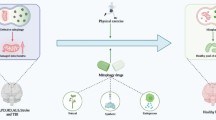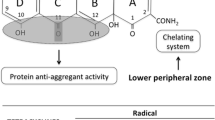Abstract
Numerous studies reveal that Angiotensin II (Ang II), the main effector of renin-angiotensin system, contributes to the pathogenesis of Parkinson’s disease (PD) via triggering dopaminergic cell loss. However, the underlying mechanisms remain largely unclear. In the current study, by using CATH.a cell, a dopaminergic neuronal cell line stably expressing Angiotensin II type 1 receptor (AT1R) and Angiotensin II type 2 receptor (AT2R), we showed that Ang II treatment triggered cell apoptosis in a dose-dependent manner, providing the first evidence that apoptotic cell death contributed to the dopaminergic cell loss induced by Ang II. Ang II treatment also led to a significant increment in intracellular reactive oxygen species generation, which could be fully abolished by nicotinamide adenine dinucleotide phosphate (NADPH) oxidase inhibitors apocynin or diphenylene iodonium, indicating that Ang II enhanced oxidative stress via a NADPH oxidase-dependent manner. More importantly, inhibition of oxidative stress by NADPH oxidase inhibitors partially attenuated cell apoptosis caused by Ang II, implying that the enhancement of NADPH oxidase-dependent oxidative stress contributed to the cell apoptosis triggered by Ang II. Furthermore, the Ang II-induced oxidative stress and subsequent apoptosis could be completely abolished by AT1R blocker losartan rather than AT2R blocker PD1223319, suggesting that the aforementioned detrimental effects of Ang II are mediated by AT1R. In summary, these findings have deepened our understanding on the role of Ang II in PD pathogenesis, and support the use of AT1R blockers in the treatment of this devastating disease.





Similar content being viewed by others
References
Jiang T, Yu JT, Tian Y, Tan L (2013) Epidemiology and etiology of Alzheimer’s disease: from genetic to non- genetic factors. Curr Alzheimer Res 10(8):852–867
Wirdefeldt K, Adami HO, Cole P, Trichopoulos D, Mandel J (2011) Epidemiology and etiology of Parkinson’s disease: a review of the evidence. Eur J Epidemiol 26(Suppl 1):S1–S58. doi:10.1007/s10654-011-9581-6
Schapira AH (2009) Neurobiology and treatment of Parkinson’s disease. Trends Pharmacol Sci 30(1):41–47. doi:10.1016/j.tips.2008.10.005
Schapira AH, Jenner P (2011) Etiology and pathogenesis of Parkinson’s disease. Mov Disord Off J Mov Disord Soc 26(6):1049–1055. doi:10.1002/mds.23732
Nguyen Dinh Cat A, Touyz RM (2011) A new look at the renin-angiotensin system–focusing on the vascular system. Peptides 32(10):2141–2150. doi:10.1016/j.peptides.2011.09.010
Herr D, Bekes I, Wulff C (2013) Local renin-angiotensin system in the reproductive system. Front Endocrinol 4:150. doi:10.3389/fendo.2013.00150
Marquez E, Riera M, Pascual J, Soler MJ (2014) Renin angiotensin system within the diabetic podocyte. Am J Physiol Ren Physiol Ajprenal 00531:02013. doi:10.1152/ajprenal.00531.2013
Giese MJ, Speth RC (2014) The ocular renin-angiotensin system: a therapeutic target for the treatment of ocular disease. Pharmacol Ther 142(1):11–32. doi:10.1016/j.pharmthera.2013.11.002
Wright JW, Harding JW (2011) Brain renin-angiotensin–a new look at an old system. Prog Neurobiol 95(1):49–67. doi:10.1016/j.pneurobio.2011.07.001
Jiang T, Gao L, Lu J, Zhang YD (2013) ACE2-Ang-(1-7)-Mas axis in brain: a potential target for prevention and treatment of ischemic stroke. Curr Neuropharmacol 11(2):209–217. doi:10.2174/1570159X11311020007
Labandeira-Garcia JL, Garrido-Gil P, Rodriguez-Pallares J, Valenzuela R, Borrajo A, Rodriguez-Perez AI (2014) Brain renin-angiotensin system and dopaminergic cell vulnerability. Front neuroanat 8:67. doi:10.3389/fnana.2014.00067
Rodriguez-Pallares J, Rey P, Parga JA, Munoz A, Guerra MJ, Labandeira-Garcia JL (2008) Brain angiotensin enhances dopaminergic cell death via microglial activation and NADPH-derived ROS. Neurobiol Dis 31(1):58–73. doi:10.1016/j.nbd.2008.03.003
Valenzuela R, Barroso-Chinea P, Villar-Cheda B, Joglar B, Munoz A, Lanciego JL, Labandeira-Garcia JL (2010) Location of prorenin receptors in primate substantia nigra: effects on dopaminergic cell death. J Neuropathol Exp Neurol 69(11):1130–1142. doi:10.1097/NEN.0b013e3181fa0308
Wu L, Tian YY, Shi JP, Xie W, Shi JQ, Lu J, Zhang YD (2013) Inhibition of endoplasmic reticulum stress is involved in the neuroprotective effects of candesartan cilexitil in the rotenone rat model of Parkinson’s disease. Neurosci Lett 548:50–55. doi:10.1016/j.neulet.2013.06.008
Sonsalla PK, Coleman C, Wong LY, Harris SL, Richardson JR, Gadad BS, Li W, German DC (2013) The angiotensin converting enzyme inhibitor captopril protects nigrostriatal dopamine neurons in animal models of parkinsonism. Exp Neurol 250:376–383. doi:10.1016/j.expneurol.2013.10.014
Asanuma M, Miyazaki I, Kikkawa Y, Kimoto N, Takeshima M, Murakami S, Miyoshi K (2012) Cyclooxygenase-independent neuroprotective effects of aspirin against dopamine quinone-induced neurotoxicity. Neurochem Res 37(9):1944–1951. doi:10.1007/s11064-012-0813-2
Lu J, Wu L, Jiang T, Wang Y, Zhao H, Gao Q, Pan Y, Tian Y, Zhang Y (2014) Angiotensin AT receptor stimulation inhibits activation of NADPH oxidase and ameliorates oxidative stress in rotenone model of Parkinson’s disease in CATH.a cells. Neurotoxicol Teratol 47C:16–24. doi:10.1016/j.ntt.2014.11.004
Chen SS, Jiang T, Wang Y, Gu LZ, Wu HW, Tan L, Guo J (2014) Activation of double-stranded RNA-dependent protein kinase inhibits proliferation of pancreatic beta-cells. Biochem Biophys Res Commun 443(3):814–820. doi:10.1016/j.bbrc.2013.12.051
Wu L, Luo N, Zhao HR, Gao Q, Lu J, Pan Y, Shi JP, Tian YY, Zhang YD (2014) Salubrinal protects against rotenone-induced SH-SY5Y cell death via ATF4-parkin pathway. Brain Res 1549:52–62. doi:10.1016/j.brainres.2014.01.003
Jiang T, Yu JT, Zhu XC, Tan MS, Wang HF, Cao L, Zhang QQ, Shi JQ, Gao L, Qin H, Zhang YD, Tan L (2014) Temsirolimus promotes autophagic clearance of amyloid-beta and provides protective effects in cellular and animal models of Alzheimer’s disease. Pharmacol Res Off J Ital Pharmacol Soc 81:54–63. doi:10.1016/j.phrs.2014.02.008
Jiang T, Yu JT, Zhu XC, Wang HF, Tan MS, Cao L, Zhang QQ, Gao L, Shi JQ, Zhang YD, Tan L (2014) Acute metformin preconditioning confers neuroprotection against focal cerebral ischemia by pre-activation of AMPK-dependent autophagy. Br J Pharmacol. doi:10.1111/bph.12655
Jiang T, Tan L, Zhu XC, Zhang QQ, Cao L, Tan MS, Gu LZ, Wang HF, Ding ZZ, Zhang YD, Yu JT (2014) Upregulation of TREM2 ameliorates neuropathology and rescues spatial cognitive impairment in a transgenic mouse model of Alzheimer’s disease. Neuropsychopharmacol Off Publ Am Coll Neuropsychopharmacol 39(13):2949–2962. doi:10.1038/npp.2014.164
Jiang T, Yu JT, Zhu XC, Tan MS, Gu LZ, Zhang YD, Tan L (2014) Triggering receptor expressed on myeloid cells 2 knockdown exacerbates aging-related neuroinflammation and cognitive deficiency in senescence-accelerated mouse prone 8 mice. Neurobiol Aging 35(6):1243–1251. doi:10.1016/j.neurobiolaging.2013.11.026
Creagh EM (2014) Caspase crosstalk: integration of apoptotic and innate immune signalling pathways. Trends Immunol 35(12):631–640. doi:10.1016/j.it.2014.10.004
Dikalov SI, Nazarewicz RR, Bikineyeva A, Hilenski L, Lassegue B, Griendling KK, Harrison DG, Dikalova AE (2014) Nox2-induced production of mitochondrial superoxide in angiotensin II-mediated endothelial oxidative stress and hypertension. Antioxid Redox Signal 20(2):281–294. doi:10.1089/ars.2012.4918
Wang HX, Yang H, Han QY, Li N, Jiang X, Tian C, Du J, Li HH (2013) NADPH oxidases mediate a cellular “memory” of angiotensin II stress in hypertensive cardiac hypertrophy. Free Radic Biol Med 65:897–907. doi:10.1016/j.freeradbiomed.2013.08.179
Kleikers PW, Wingler K, Hermans JJ, Diebold I, Altenhofer S, Radermacher KA, Janssen B, Gorlach A, Schmidt HH (2012) NADPH oxidases as a source of oxidative stress and molecular target in ischemia/reperfusion injury. J Mol Med 90(12):1391–1406. doi:10.1007/s00109-012-0963-3 (Berl)
Vignais PV (2002) The superoxide-generating NADPH oxidase: structural aspects and activation mechanism. Cell Mol Life Sci CMLS 59(9):1428–1459
Baillet A, Chanteperdrix V, Trocme C, Casez P, Garrel C, Besson G (2010) The role of oxidative stress in amyotrophic lateral sclerosis and Parkinson’s disease. Neurochem Res 35(10):1530–1537. doi:10.1007/s11064-010-0212-5
Dasuri K, Zhang L, Keller JN (2013) Oxidative stress, neurodegeneration, and the balance of protein degradation and protein synthesis. Free Radic Biol Med 62:170–185. doi:10.1016/j.freeradbiomed.2012.09.016
Onyango IG (2008) Mitochondrial dysfunction and oxidative stress in Parkinson’s disease. Neurochem Res 33(3):589–597. doi:10.1007/s11064-007-9482-y
Miller RL, James-Kracke M, Sun GY, Sun AY (2009) Oxidative and inflammatory pathways in Parkinson’s disease. Neurochem Res 34(1):55–65. doi:10.1007/s11064-008-9656-2
Liu J, Zhang FF, Li L, Yang J, Guan YY, Du YH (2013) ClC-3 deficiency prevents apoptosis induced by angiotensin II in endothelial progenitor cells via inhibition of NADPH oxidase. Apoptosis Int J Program Cell Death 18(10):1262–1273. doi:10.1007/s10495-013-0881-z
Wu B, Lin R, Dai R, Chen C, Wu H, Hong M (2013) Valsartan attenuates oxidative stress and NF-kappaB activation and reduces myocardial apoptosis after ischemia and reperfusion. Eur J Pharmacol 705(1–3):140–147. doi:10.1016/j.ejphar.2013.02.036
Yamamoto E, Tamamaki N, Nakamura T, Kataoka K, Tokutomi Y, Dong YF, Fukuda M, Matsuba S, Ogawa H, Kim-Mitsuyama S (2008) Excess salt causes cerebral neuronal apoptosis and inflammation in stroke-prone hypertensive rats through angiotensin II-induced NADPH oxidase activation. Stroke J Cereb Circ 39(11):3049–3056. doi:10.1161/STROKEAHA.108.517284
Akishita M, Nagai K, Xi H, Yu W, Sudoh N, Watanabe T, Ohara-Imaizumi M, Nagamatsu S, Kozaki K, Horiuchi M, Toba K (2005) Renin-angiotensin system modulates oxidative stress-induced endothelial cell apoptosis in rats. Hypertension 45(6):1188–1193. doi:10.1161/01.HYP.0000165308.04703.f2
Tan Y, Li X, Prabhu SD, Brittian KR, Chen Q, Yin X, McClain CJ, Zhou Z, Cai L (2012) Angiotensin II plays a critical role in alcohol-induced cardiac nitrative damage, cell death, remodeling, and cardiomyopathy in a protein kinase C/nicotinamide adenine dinucleotide phosphate oxidase-dependent manner. J Am Coll Cardiol 59(16):1477–1486. doi:10.1016/j.jacc.2011.12.034
Acknowledgments
This work was supported by the grants from the Innovation Project for Postgraduates of Jiangsu Province to T.J. (CXLX13_561), the National Natural Science Foundation of China (81271418) and the Six Talent Summit of Jiangsu Province to Y.D.Z. (N02012-WS-086), and the Natural Science Foundation of Jiangsu Province to Y.Y.T. (BK2012524).
Conflicts of Interest
The authors declare no conflict of interest.
Author information
Authors and Affiliations
Corresponding authors
Additional information
Hong-Rui Zhao and Teng Jiang should be regarded as co-first authors.
Rights and permissions
About this article
Cite this article
Zhao, HR., Jiang, T., Tian, YY. et al. Angiotensin II Triggers Apoptosis Via Enhancement of NADPH Oxidase-Dependent Oxidative Stress in a Dopaminergic Neuronal Cell Line. Neurochem Res 40, 854–863 (2015). https://doi.org/10.1007/s11064-015-1536-y
Received:
Revised:
Accepted:
Published:
Issue Date:
DOI: https://doi.org/10.1007/s11064-015-1536-y




